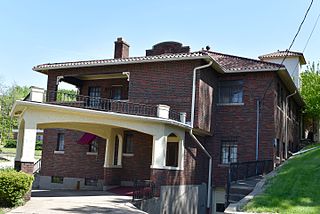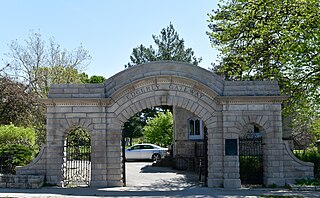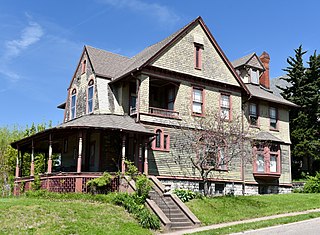
The Washington Park Historic District is a national historic district located in Indianapolis, Indiana. It was listed on the National Register of Historic Places on June 24, 2008. It comprises nearly 60 acres (240,000 m2) and is located 4 miles (6.4 km) north of downtown Indianapolis, in the south-central part of the Meridian-Kessler neighborhood. The district includes all properties south of 43rd Street and north of 40th Street, and west of Central Avenue and east of the alley running north and south between Pennsylvania and Meridian Streets; Washington Boulevard runs north-south through the center of the district. It includes 110 contributing buildings, ranging mostly from mansions to small bungalows, and three non-contributing buildings.

The Whitney Avenue Historic District is a historic district in the East Rock neighborhood of New Haven, Connecticut. It is a 203-acre (82 ha) district which included 1,084 contributing buildings when it was listed on the National Register of Historic Places in 1989.

The Woodlawn Historic District is a nationally recognized historic district located in Iowa City, Iowa, United States. It was listed on the National Register of Historic Places in 1979. At the time of its nomination it consisted of 14 resources, all of which are contributing buildings. The district is largely on Woodlawn Street, a gravel dead-end extension of Iowa Avenue. The eastern terminus of Iowa Avenue was originally planned to be a block to the west and was to be the location of the Governor's Mansion, but it was never built. The Old Capitol is on western terminus of the same street. The district is an enclave of upper-middle-class houses on Woodlawn and Evans Streets. Nine of the houses were built in the late 19th century, two were built in the 1920s, and two were built in mid-20th century. There is also a four-story Tudor Revival apartment building on Evans Street that was built in 1926. All of the buildings are located on deep set-backs on large landscaped lots that provide seclusion and cohesion, which is what gives them their significance. The most prominent house is a Queen Anne style home at 1036 Woodlawn Street.

The Beaver Hills Historic District is a 97-acre (39 ha) historic district in the Beaver Hills neighborhood of New Haven, Connecticut. It was listed on the National Register of Historic Places in 1986. In 1986, it included 235 contributing buildings.

The Riverview Terrace Historic District is a 15.2-acre (6.2 ha) historic district in Davenport, Iowa, United States, that was listed on the National Register of Historic Places in 1984. It was listed on the Davenport Register of Historic Properties in 1993. The neighborhood was originally named Burrow's Bluff and Lookout Park and contains a three-acre park on a large hill.

The Ashby Manor Historic District is located in northwest Des Moines, Iowa, United States. It is a residential area that lies between Beaver Avenue, which is a major north–south artery, on the west and Ashby Park on the east. The historic period of the housing was 1925–1941. The street layout follows a curving pattern, which differentiates it from the grid pattern of the surrounding area. The streets also feature a mature tree canopy. The historic district has 148 properties of which 99 are houses and 49 are garages. Ninety-one properties are considered contributing properties and 57 are noncontributing. It has been listed on the National Register of Historic Places since 1992. It is a part of the Suburban Development in Des Moines Between the World Wars, 1918--1941 MPS.

The Chautauqua Park Historic District is located on the north side of Des Moines, Iowa, United States. It has been listed on the National Register of Historic Places since 1990. It is part of the Suburban Development in Des Moines Between the World Wars, 1918--1941 MPS.

Jay Funeral Home, now known as the Robertson-Jay Funeral Home, is an historic building and funeral home located in Ottumwa, Iowa, United States. Local architect Archie Eaton designed the building in the Mediterranean Revival style. The two-story brick structure was completed in 1929. The exterior of the building features round arch windows, a tile roof, and a broad brick porte cochere. The building is noteworthy for its architecture and as an early example of funeral home design. It was individually listed on the National Register of Historic Places in 1995. In 1998 it was included as a contributing property in the Fifth Street Bluff Historic District.

The Benson Building, also known as the Union Bus Depot, was an historic building located in downtown Ottumwa, Iowa, United States. The Tudor Revival style commercial building was completed in 1930. The one-story structure was composed of highly textured, painted brick. The façade featured a steeply-pitched gable roof and half-timbering. The building was originally used as an indoor miniature golf course. Its significance was attributed to its architecture. It was individually listed on the National Register of Historic Places in 1995 as a part of the Ottumwa MPS. In 2016 it was included as a contributing property in the Greater Second Street Historic District.

Ottumwa Cemetery is a public cemetery located in Ottumwa, Iowa, United States. The entrance area of the cemetery forms a historic district that was listed on the National Register of Historic Places in 1995. At the time of its nomination it was composed of four resources, which included two contributing buildings and two contributing structures.

The Fifth Street Bluff Historic District is a nationally recognized historic district located in Ottumwa, Iowa, United States. It was listed on the National Register of Historic Places in 1998. At the time of its nomination it contained 67 resources, which included 40 contributing buildings, three contributing structures, and 24 non-contributing buildings.

Court Hill Historic District is a historic district located in Ottumwa, Iowa, United States. It is a residential area of large homes with a few small homes in between. The district was listed on the National Register of Historic Places in 1998 as a part of Ottumwa MPS. At the time of its nomination it contained 84 resources, which included 56 contributing buildings, two contributing structures, 25 non-contributing buildings, and one non-contributing site.

The St. Joseph Hospital Historic District is a former Catholic hospital campus and nationally recognized historic district located in Ottumwa, Iowa, United States. It was listed on the National Register of Historic Places in 2015. At the time of its nomination it contained three resources, which included two contributing buildings, and one contributing structure. Previously, the hospital building was included as a contributing property in the Vogel Place Historic District.
The Foster Park Historic District is a nationally recognized historic district located in Le Mars, Iowa, United States. It was listed on the National Register of Historic Places in 2008. At the time of its nomination the district consisted of 237 resources, including 166 contributing buildings, one contributing site, 65 non-contributing buildings, one non-contributing structure, and four non-contributing objects. The district comprises ten full blocks and nine half blocks. The historic buildings are houses and their attendant garages, carriage houses, or barns. The houses are between one and 2½-stories and are composed of frame, brick or stucco construction. For the most part they were built between the 1880s and the 1930s. Architectural styles include the revivals styles of the Late Victorian era to the Colonial Revival and American Craftsman styles of the early 20th century. Sioux City architect William L. Steele has several commissions in the district, as do other architects. Foster Park was established on one of the blocks along Central Avenue. It became a focal point for the neighborhood.

The Willow–Bluff–3rd Street Historic District is a nationally recognized historic district located in Council Bluffs, Iowa, United States. It was listed on the National Register of Historic Places in 2005. At the time of its nomination the district consisted of 260 resources, including 162 contributing buildings, 56 contributing structures, 36 non-contributing buildings, and six non-contributing structures. The district is primarily a residential area that is adjacent to the central business district to the west. Part of the district is in Jackson's Addition, which is the first addition to the original town of Council Bluffs. It also sits along the base of the loess bluffs to the east.

Old Town Historic District is a nationally recognized historic district located in Ames, Iowa, United States. It was listed on the National Register of Historic Places in 2004. At the time of its nomination it consisted of 249 resources, which included 191 contributing buildings, one contributing site, and 57 non-contributing buildings. The district is a residential area located north of the central business district. Between the two is a "civic corridor" made up of government buildings, churches and fraternal organizations. The earlier residences here were built of brick, but from about 1890 to 1910 they are all of wood construction. Brick reappears in 1910, but as a secondary building material. The houses are from one to two stories in height. They reflect the Late Victorian styles as well as the Colonial Revival styles of the early 20th century. The houses generally have a detached garage behind the house, facing an alley. The Prof. J.L. Budd, Sarah M., and Etta Budd House (1885) is individually listed on the National Register.

The Brown Street Historic District is a nationally recognized historic district located in Iowa City, Iowa, United States. It was listed on the National Register of Historic Places in 1994, and its boundaries were increased in 2004. At the time of the boundary increase it consisted of 246 resources, which included 201 contributing buildings, one contributing structure, and 44 non-contributing buildings. Brown and East Ronalds Streets are both part of the city's original plat when it was laid out as the capitol of the Iowa Territory. They are located on the north edge of the plat. Its significance is derived from the settlement patterns here, the development of a major transportation corridor, the neighborhood's affiliation with the University of Iowa and its growth around the turn of the 20th century, and the architectural styles and forms that are found here from the 1850s to the 1920s. Many of the city's Bohemian-immigrant population lived here. Businessmen and blue-collar workers lived side by side to each other, as did professors from the University of Iowa. The old Military Road was routed on Brown Street, and after it was paved with bricks in 1907, it became the preferred route for funeral processions to Oakland Cemetery.

The Forest Park Historic District is a nationally recognized historic district located in Mason City, Iowa, United States. It was listed on the National Register of Historic Places in 2015. At the time of its nomination it contained 403 resources, which included 291 contributing buildings, of which 201 are houses and 90 are garages, and 112 non-contributing buildings. The historic district is a residential area located to the west of the central business district. It was platted between 1912 and 1916. Initial development in the 1910s was slow, but from the 1920s into the early 1940s, development was steady. It dropped off again after World War II as most of the lots had been developed by then. The houses range in height from one to 2½-stories. Those on Crescent, Linden, and Beaumont are larger in scale, while the rest are more modest in size. The foundations are generally brick or tile and the exteriors are clad in wood, with a few clad in brick. Architectural styles that were popular from early to mid-20th century are represented. The most popular include Prairie School, American Craftsman, Tudor Revival, Colonial Revival, and Modern. For the most part, the house designs came from a pattern book or catalogue. The streets on the west side of the district follow a grid pattern, while those on the east side are curvilinear. The neighborhood has a large tree canopy with trees planted in yards and in the boulevards along the streets.

The Fair Oaks Historic District is a nationally recognized historic district located in Muscatine, Iowa, United States. It was listed on the National Register of Historic Places in 2020. At the time it was studied for the Muscatine Historic Preservation Commission it contained 231 resources, which included 176 contributing buildings and 55 non-contributing buildings. Dr. James Weed was an early settler in Muscatine. He married Mary Swift in 1847, and the couple settled a farm on the northeast side of town where they built a Gothic Revival house from 1852 to 1854. The couple donated 63 acres (25 ha) of wooded land on the east side of their property along the Mississippi River for a community park. Along the southern and western edges of their property, they plated subdivisions and eight houses had been built by the time of Mary's death in 1908. The rest of their property was opened up for development at that time and it was given the name Fair Oaks in a city-wide contest. It was divided into 101 lots. There were 57 houses in the subdivision by 1919, and 25 houses and a grocery store were built in the 1920s. Between 1930 and 1944 another 15 houses were built, 11 houses between 1945 and 1954, 13 houses between 1955 and 1965, and four houses since 1965.
The Washington and Elizabeth Miller Tract-Center-Soll Community Historic District is a nationally recognized historic district located in Des Moines, Iowa, United States. At the time of its nomination it consisted of 471 resources, which included 297 contributing buildings and 174 non-contributing buildings. It was listed on the National Register of Historic Places in 2017.





















